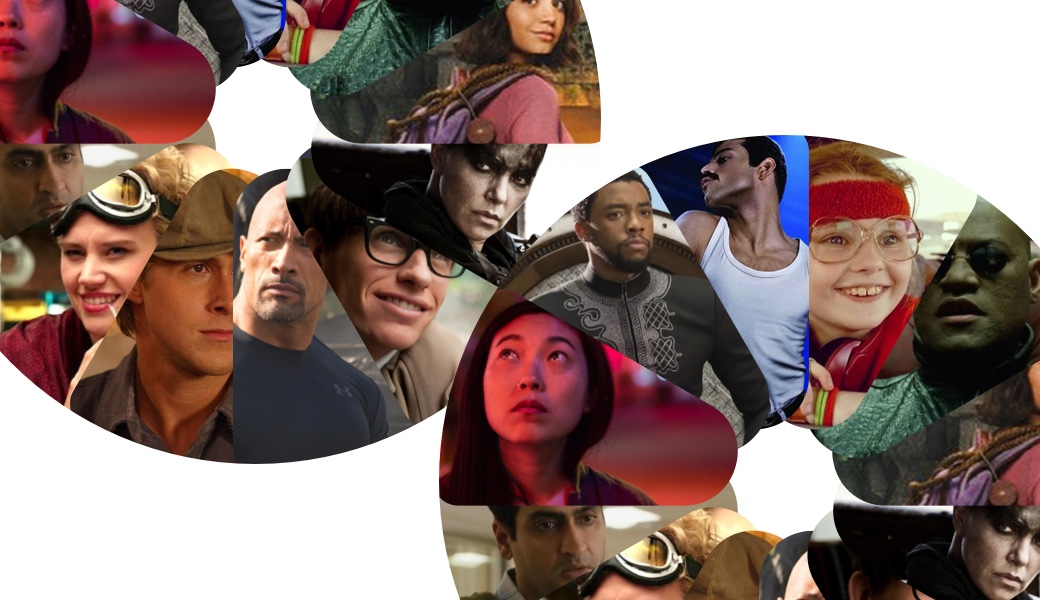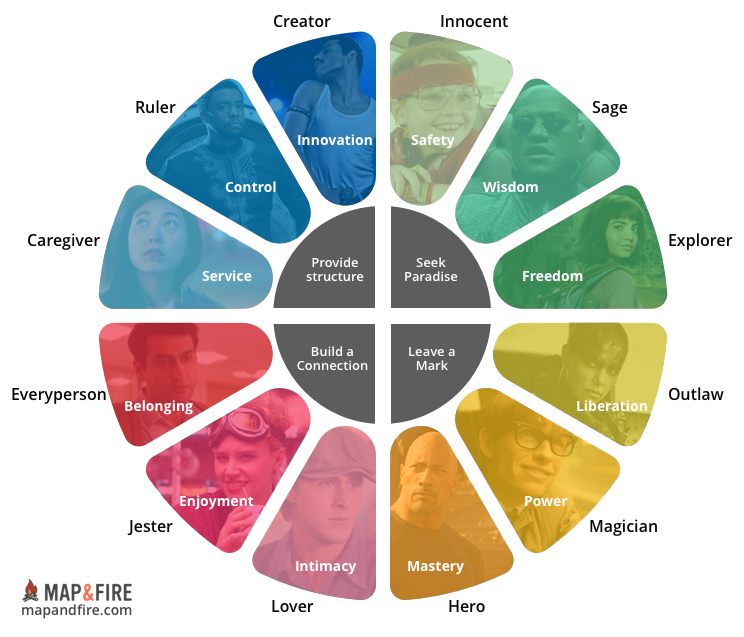
At Map & Fire, we define a brand as a relationship between your company and your customers. The challenge is that a relationship is an abstract concept. This makes creating an authentic voice for a brand a tricky thing to wrap your head around.
To help us move from the abstract into something more concrete, brand archetypes are a valuable tool.
Archetypes allow us to apply human characteristics to our brand. They help us flesh out a brand into three dimensional beings.
By thinking of your brand as a character it makes it a lot easier to develop a voice — i.e. defining not just what you’re saying but how you’re saying it.
An authentic brand voice can make functional descriptions and ideas feel like they came from an actual, living, breathing person.
Given that we’re talking about building relationships with customers, making your brand feel like a real person is a pretty big asset.
You can think of an authentic voice as the first link in a larger, trust-building chain for your brand:
- An authentic brand voice, allows for…
- Engaging communication, which helps build…
- Customer trust, which leads to…
- Customer loyalty, which provides…
- Long term growth and success for your business
Let’s see how brand archetypes can help us establish that first, critical link.
Going Beyond A One Dimensional Brand
We have a big resource section on brand archetypes in the Map & Fire Field Guide if you want to do a deep dive on the topic.
The short version is that archetypes represent highly recognizable character types that we see repeated through all forms of storytelling.

Each one represents a unique set of attributes and behaviors that tell us what to expect from the character who embodies them.
Looking at the analytics for our brand archetype content, there are some that are definitely more popular than others.
The top brand archetypes based on monthly page views (and relative percent share of views) are:
- Outlaw (8.56)
- Hero (7.66)
- Magician (5.07)
- Sage (4.86)
- Caregiver (4.59)
- Creator (4.49)
- Jester (4.12)
- Everyperson (3.59)
- Explorer (3.28)
- Ruler (3.16)
- Lover (2.78)
- Innocent (2.63)
Obviously our site is just one of many resources for archetypes. But the fact that certain archetypes get 2-3x as much attention, may reflect a tendency to get locked into one idea for an archetype without exploring all the other options.
The danger with that is it can skew your brand’s character into feeling one dimensional. More like a caricature than an authentic person who you’d trust.
In our brand consulting work, we take a different approach.
The main exercise we use revolves around selecting three archetypes for your brand.

As the structure highlights, you start with a primary archetype that most aligns with your brand’s position. This archetype represents the character that best complements the foundational needs of your customers.
But then we follow that by selecting secondary and tertiary archetypes to build out a unique combination of attributes.
While we don’t have strict rules about the weight of each, a rule of thumb is to think of it as a split of:
- Primary Archetype: 60%
- Secondary Archetype: 30%
- Tertiary Archetype: 10%
This blend is the key to helping us achieve that well-rounded, authentic voice.
What A Blend Of Archetypes Feels Like In Practice
To help highlight how a blend of archetypes feels, let’s start with an example from our brand archetype wheel graphic.
In the Ruler slot we have T’Challa, the lead character in the Marvel superhero film Black Panther, played by the talented, late Chadwick Boseman.
In the film, T’Challa is the king of the fictional country of Wakanda. His primary responsibility is to serve as ruler and leader.

But his character is far from one dimensional. In addition to being a Ruler and Hero, T’Challa embodies attributes of the Everyperson with his sense of respect and fairness. And while he’s not the main comic relief of the film he definitely has a dash of Jester in him, too.
Collectively, this all equates to a fully realized person. Even in the fantastic world of superheros, a character as well developed as T’Challa makes you feel more emotionally connected to him.
We can apply this exact same set of principles in the business world.
A great example of blended archetypes on the brand side comes from the company, Oatly.

This incredibly fast-growing producer of oat milk products has crafted a unique and memorable voice for its brand.
At first glance, their emphasis on humor and irreverence might have you slot them in the Jester category.
But below that tongue-in-cheek surface, is Oatly’s focus on environmental sustainability. This compassionate, altruistic mission aligns well with a Caregiver archetype.
And for those seeking to go deep on the science and nutrition behind their products, their voice seamlessly switches gears into an intellectual Sage mode.
When you put all these pieces together, you end up with a brand that’s entertaining, caring, smart, and totally authentic.
Those are the qualities that build a foundation of trust.
Finding Your Complementary Mix Of Archetypes
To move beyond singular archetype thinking and develop a well-rounded mix for your business, we can utilize another aspect of the wheel.

In addition to the 12 individual archetypes the wheel is divided into 4 sections each centered on a particular theme.
Here are the steps to find a mix of archetypes that can balance your brand voice:
- Select the primary archetype that aligns with your brand’s position
- Look at the theme of the quadrant your primary archetype is in
- Look at the other quadrants to find a theme that would be relevant and complementary to the relationship you want to build with your customers
- Select a supporting archetype within that quadrant that could help round out your brand
- Repeat that cycle one more time looking at another quadrant and potential tertiary archetype
By focusing on the themes around your archetypes it helps you explore diverse sets of attributes. It also brings clarity on what role those attributes serve within your brand.
As an example, if you have a service-based company that leans strongly as a Caregiver (Provide Structure) you may benefit from archetypes in the Build a Connection theme to amplify the more personal side of the brand.
Or if you’re Hero-focused (Leave a Mark), there may be ways to mix in Sage (Seek Paradise) to pair some brains with your brawn.
Give Your Brand An Authentic, Fully Realized Voice
It’s not easy to build trust with your customers. It requires a relationship that delivers value on a consistent basis.
And just like strong relationships between people, it all starts with communication.
How do you tell the story of your brand’s value in a way that’s clear, memorable, and authentic?
By giving your brand a set of well-rounded characteristics, you can move beyond a one-note, caricature and talk with your customers like a real human being.
It won’t create instant loyalty with customers but it will help get your relationship off on the right foot.

Get Help Crafting An Authentic Brand Voice
If you’re ready to build stronger connections with your customers, reach out for a free consultation. We’ll help you transform your best business thinking into an actionable, shareable, growth-oriented guide. Click below to learn more about the Brand Guidebook process.

